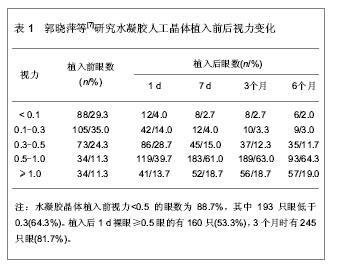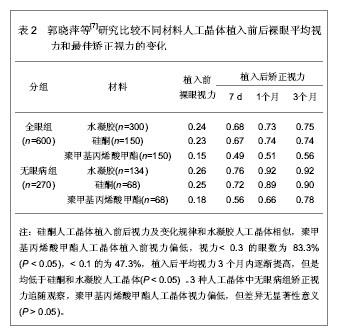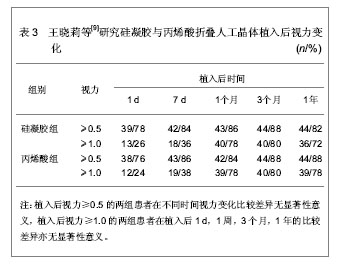2 人工晶体材料的分类和选择
2.1 按照材料硬度分类 按照人工晶体材料的硬度可以分为硬性人工晶体和软性人工晶体两种。非折叠式人工晶体属于硬性人工晶体,不能将其折叠植入,植入后的不良反应较大。折叠式人工晶体属于软性人工晶体,植入时所需的切口较小,术眼的视力恢复较快,且不良反应比非折叠式人工晶体要小,散光较小。根据患者所选择的折叠式或非折叠式人工晶体可以确定植入时的切口大小,普通硬性非折叠式人工晶体的切口一般在6 mm可以将其植入,还需要在切口处缝线,这样容易造成散光,而折叠式人工晶体只需要2.0-3.0 mm或者更小的切口就可以将人工晶体植入眼内。
非折叠式人工晶体在价格上低于折叠式人工晶体,对于白内障已经接近成熟的患者,无法应用超声乳化方法,治疗切口必须要达到5.0-6.0 mm时,均可选择硬性非折叠式人工晶体植入。折叠式人工晶体是目前最常用的植入材料,先将人工晶体折叠好,并放在特殊的植入器里,推到眼球里面展开的,所以切口一般是3.2-3.5 mm,并且切口不需要缝合,散光的发生率也比较小,恢复时间更快一些。但折叠式人工晶体的价格会高于非折叠式人工晶体的1-3倍。
2.2 按照安放位置分类 人工晶体按照其安放的位置可以分为前房固定型人工晶体、虹膜固定型人工晶体以及后房固定型人工晶体。一般情况下,人工晶体安放的最佳位置是在天然晶状体的囊袋内,也就是后房固定型人工晶体的位置,这个位置可以较好的保证人工晶体处于居中,并且与周围组织之间没有摩擦,使炎症反应发生时较轻或较少发生。但是也可以把人工晶体安放在前房或虹膜的位置,如可以对晶体囊袋破裂的患者将人工晶体放置在前房,也可以对有晶体的眼内植入人工晶体。
2.3 多焦点或可调节人工晶体 对于经常看远或看近处物体的患者,可以选择多焦点人工晶体,一般的人工晶体在植入后只能有1个焦点,看远处清楚,看近处需要佩戴老花镜来解决,或者看近处清楚,看远处需要佩戴近视镜。多焦点人工晶体是在1片人工晶体上做出2个焦点,1个焦点用来看远处,1个焦点用来看近处,解决了单一焦点的不足。但多焦点人工晶体也有一定弊端,从成像原理上看,2个焦点的人工晶体中,使用其中1个晶体,另1个晶体必然是离焦的状态,也就是说视网膜上会有2个成像,1个是清楚的,1个是模糊的。多焦点人工晶体不论是折射型还是衍射型,都是利用瞳孔的反射来改变远近焦点的能量分配,尽可能使清楚的能量多,模糊的能量少,这样的成像需要患者逐渐适应才可以。可调节人工晶体的原理是移动人工晶体的位置,靠位置的移动来改变度数。但在视力恢复过程中,支撑人工晶体的囊袋可能会逐渐变硬,失去弹性,于是人工晶体的位置也就相对固定,解决囊袋纤维化的问题是可调节人工晶体的研究重点。
此外,还有非球面人工晶体,与球面人工晶体相比,在视觉感受和质量方面表现的更为清晰,可以减小像差。带散光人工晶体,有角膜散光的患者可以选择带散光的晶体,从而获得较好的裸眼视力。

3 人工晶体的材料学特征
人工晶体材料主要是由线性的多聚物和交连剂所组成。通过改变多聚物的化学组成来加以区分,如可以改变人工晶体的折射率、硬度等。
3.1 聚甲基丙烯酸甲酯 聚甲基丙烯酸甲酯是最早研究的一种疏水性丙烯酸酯人工晶体,只能生产硬性人工晶体,是最早而且惟一可以用于治疗糖尿病患者的人工晶体。聚甲基丙烯酸甲酯人工晶体的材料稳定、质轻、透明度好[4],屈光指数大,不会被机体的生物氧化反应所降解,对机体的生物反应较轻,对老化以及环境中其它变化的抵抗力也很强,折射率约为1.491,能透过较宽范围的波长,包括紫外光谱。聚甲基丙烯酸甲酯人工晶体植入后的眼与无晶状体眼可以同样的感受颜色更亮、更饱和,聚甲基丙烯酸甲酯人工晶体是硬性材料的首选,但主要缺点是不能耐受高温高压消毒。
Findl等[5]比较具有锐利光学边缘与圆形边缘的聚甲基丙烯酸甲酯人工晶体抑制后囊混浊形成的作用,选取32例(64只眼)患有双侧年龄相关性白内障的患者行双眼超声乳化白内障吸除治疗,其中1眼植入具有锐利光学边缘设计的聚甲基丙烯酸甲酯人工晶体,另1眼植入圆形边缘的聚甲基丙烯酸甲酯人工晶体。结果发现锐利光学边缘的人工晶体在植入后很少出现再生的和纤维化的后囊混浊。植入具有锐利光学边缘与植入圆形边缘人工晶体的患眼在第5年的后囊混浊评分的均差为2.83(95% CI 1.66-4.00)。可见,具有锐利光学边缘设计的聚甲基丙烯酸甲酯人工晶体能够显著降低后囊混浊的发生率,但不能完全阻止后囊混浊的发生。
3.2 玻璃材料 玻璃材料的人工晶体其透明度较好,屈光指数大,更耐久,可以耐受高压消毒,但玻璃人工晶体质量较重,易导致镜心偏移和脱位。而且受到激光击射后会发生碎裂,无法在人工晶体植入后治疗晶状体后囊混浊。因此,玻璃人工晶体早已被其它材料所取替。
3.3 硅胶材料 硅胶制成的人工晶体属于软性人工晶体,有充足的柔韧性,折叠式硅胶人工晶体可以通过小切口植入眼内,是目前临床上使用最广泛的软性人工晶体,其次是聚甲基丙烯酸羟乙酯。硅胶人工晶体的前表面为非球面,有一系列重复的连续的晶状体屈折力,晶体视部中央4.7 mm直径范围内有5个非球面形的环形区域,环形区之间的过渡较平缓,这种设计可提供由远到近的焦点范围,也减少引起眩光和光晕量的可能。硅胶型设计可减少人工晶体偏位、倾斜和术后散光的影响。
3.4 水凝胶材料 水凝胶人工晶体根据聚合体中的含水率和性质可以分为高含水率水凝胶和聚甲基丙烯酸羟乙酯。水凝胶材料人工晶体属于折射型,不会发生高阶衍射而丢失部分入射光线的能量,所有入射光线全部应用于视觉系统。水凝胶人工晶体是应用折射和/或衍射的光学原理,使经过多焦人工晶体的光线产生2个或多个焦点,使远处和近处物体发出的光线均能聚焦于视网膜上。郭晓萍等[6]发现水凝胶单体折叠式人工晶体植入治疗白内障后视力恢复良好,中心稳定,是较好的小切口无缝线植入材料。同时研究一体式水凝胶折叠人工晶体植入的疗效[7],并与其他材料进行比较,结果见表1,2。

3.5 丙烯酸酯材料 丙烯酸酯是由苯乙基丙烯酸酯和苯乙基甲基丙烯酸组成的共聚体,属于聚甲基丙烯酸甲酯系列,具有与聚甲基丙烯酸甲酯相似的光学和生物学特性,属于软性可折叠式人工晶体,稳定性良好[8]。丙烯酸酯材料人工晶体以Alcon公司生产的SA60A-L型Acrysof人工晶体为代表,单片设计并与光学部为一个整体。丙烯酸酯人工晶体可吸收紫外线,屈光指数为1.55,光学部直径为55 mm,人工晶体全长为125 mm,适于植入晶状体囊袋内。大多数人工晶体可以阻挡太阳光中的紫外光线,但不能够滤过光谱中的蓝光部分,近来有学者提出,这一部分的光线对于视网膜特别是黄斑区有损伤作用。为了解决这一问题,Aleon公司最新推出Acrysof natural蓝光滤过型人工晶体,是在丙烯酸酯材料中增加了黄色载色基团,可以滤过有害的蓝光,是目前最接近人眼生理状态的人工晶体。

王晓莉等[9]对比硅凝胶与丙烯酸折叠人工晶体植入的疗效,硅凝胶人工晶体组植入前视力<0.1的有15只眼,视力0.1-0.5的有9只眼,丙烯酸人工晶体组植入前视力< 0.1的有13只眼,视力0.1-0.5的有10只眼。人工晶体植入后视力,见表3。

4 人工晶体材料的生物相容性
人工晶体植入后的生物相容性评价指标主要体现在后囊膜混浊、前囊膜混浊、囊膜皱缩、前房闪辉、人工晶体前细胞沉积等。后囊膜混浊是最重要的评价指标,与人工晶体的材料和设计有关。硅凝胶和疏水性丙烯酸酯人工晶体后囊膜混浊发生率均较低,水凝胶和聚甲基丙烯酸甲酯人工晶体的后囊膜混浊性白内障发生率较高[10]。Samuelson等[11]发现方形边缘设计的硅凝胶和疏水性丙烯酸酯人工晶体在植入后1年和3年的观察中,后发性白内障的发生率均较低。前房闪辉是人工晶体植入后血-房水屏障破坏和异物反应的指标。研究表明不同材料对前房闪辉无明显影响,机体对异物的反应可能由多因素决定,材料不是惟一的因素。人工晶体前细胞沉积的研究中,罗汉暄等[12]对比研究硅凝胶与丙烯酸折叠型人工晶体材料的生物相容性,发现两组患者的植入后视力比较差异有显著性意义,丙烯酸人工晶体植入后角膜水肿、前房炎症反应较轻,硅凝胶人工晶体前房反应较重,恢复时间长。硅凝胶人工晶体表面明显细胞沉积25例占83.33%,丙烯酸人工晶体表面明显细胞沉积11例占36.67%。硅凝胶人工晶体组出现1例后发性白内障,而丙烯酸人工晶体组未见后发性白内障发生。可见,丙烯酸人工晶体比硅凝胶人工晶体的生物相容性更好。
此外,人工晶体在囊袋的稳定性也是生物相容性的体现指标。人工晶体植入眼内作为一种异物,机体对此产生反应是机体正常的防御现象[13-14]。但材料不同、生产工艺不同,会出现不尽相同的反应。研究表明,注入式人工晶体植入后炎症反应较常规白内障人工晶体植入轻微。主要由于囊膜开口小,并且用囊膜塞封闭,囊袋内残留的晶状体上皮细胞不暴露于房水内,晶状体上皮细胞刺激产生的炎症递质等减少,因而产生的炎症反应轻微。
目前,人工晶体材料研究主要集中在表面修饰和材料改性两方面[15, 16]。人工晶体表面修饰主要有肝素表面修饰、氟表面修饰、碳-钛表面修饰、表面离子基团比例调节修饰、亲水-疏水微区修饰、α-烯丙基葡糖苷化合物修饰、抗炎药物修饰以及其他表面修饰方法。表面修饰技术引入到人工晶体的研究领域后,为人工晶体性能的改良开辟了新的途径和方法[17-18]。





